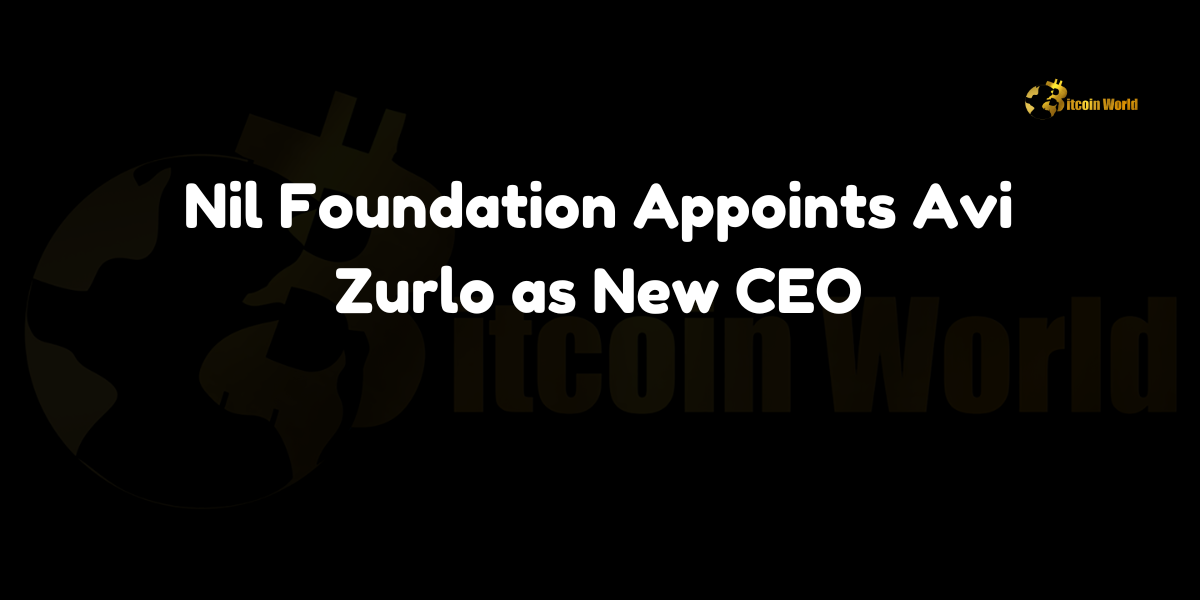Crptocurrency
Nil Foundation Appoints Avi Zurlo as New CEO

In a significant leadership move within the Ethereum scaling ecosystem, the Nil Foundation, a prominent developer of zero-knowledge (ZK) technologies, has announced the appointment of Avi Zurlo as its new Chief Executive Officer (CEO). According to Decrypt, Zurlo will spearhead initiatives aimed at improving the accessibility of zero-knowledge proofs (zkProofs) for Ethereum developers and work towards scaling the network through sharding—a process that divides a larger blockchain into more manageable segments. This strategic appointment underscores the Nil Foundation’s commitment to advancing Ethereum’s scalability and security through cutting-edge cryptographic methods.
Introduction to Nil Foundation and the Leadership Change
Who is Nil Foundation?
The Nil Foundation is at the forefront of developing zero-knowledge technologies aimed at enhancing the scalability and privacy of blockchain networks, particularly Ethereum. By leveraging zkProofs, the foundation seeks to enable secure and efficient verification of transactions without exposing underlying data, thus addressing critical challenges related to scalability and privacy in decentralized applications (dApps).
Overview of Avi Zurlo’s Appointment
The appointment of Avi Zurlo as CEO marks a pivotal moment for the Nil Foundation. Zurlo brings a wealth of experience from his previous roles in blockchain technology and strategic development, positioning him to lead the foundation in its mission to make zkProofs more accessible and to implement sharding solutions that will significantly enhance Ethereum’s performance and scalability.
Avi Zurlo’s Background and Expertise
Professional History
Avi Zurlo is a seasoned executive with extensive experience in blockchain technology, strategic planning, and technical development. Prior to joining the Nil Foundation, Zurlo held key positions at several leading blockchain firms where he played instrumental roles in developing scalable solutions and fostering innovation within the ecosystem.
Achievements and Contributions
At his previous organization, Zurlo was pivotal in the development and deployment of layer-2 scaling solutions that improved transaction throughput and reduced fees. His expertise in zero-knowledge proofs and sharding technologies has been widely recognized, making him a sought-after leader in the blockchain space.
Objectives of the New Leadership
Enhancing zkProof Accessibility
Under Zurlo’s leadership, the Nil Foundation aims to democratize access to zero-knowledge proofs for Ethereum developers. This involves creating more user-friendly tools and resources that simplify the integration of zkProofs into dApps, thereby accelerating the adoption of privacy-preserving technologies across the Ethereum network.
Advancing Sharding for Ethereum Scalability
Zurlo will also focus on the implementation of sharding within Ethereum’s infrastructure. Sharding is a method of partitioning the blockchain into smaller, more manageable pieces, or shards, each capable of processing its own transactions and smart contracts. This approach is essential for achieving the high scalability needed to support the growing number of users and applications on Ethereum.
Implications for Ethereum’s Scalability and Security
Improved Transaction Efficiency
The integration of zkProofs and sharding is expected to significantly enhance transaction efficiency on Ethereum. By verifying transactions off-chain through zkProofs, the network can handle a higher volume of transactions without compromising on security or decentralization.
Enhanced Privacy Features
Zero-knowledge proofs provide a robust framework for ensuring transaction privacy. With Zurlo’s focus on making zkProofs more accessible, developers will be empowered to build dApps that offer greater privacy features, attracting users who prioritize confidentiality and security in their digital interactions.
Future-Proofing Ethereum
The strategic initiatives led by Zurlo are designed to future-proof Ethereum by addressing both current scalability limitations and anticipating future demands. Sharding will lay the groundwork for Ethereum’s transition to a more scalable and sustainable network, capable of supporting a diverse array of applications and services.
Expert Opinions
Dr. Emily Carter, Blockchain Analyst
“Avi Zurlo’s appointment as CEO of the Nil Foundation is a strategic boon for Ethereum’s scalability initiatives. His deep understanding of zero-knowledge proofs and sharding technologies will be instrumental in overcoming the network’s current limitations and paving the way for more secure and efficient decentralized applications.”
Mark Thompson, Financial Strategist
“The focus on making zkProofs more accessible is crucial for the widespread adoption of privacy-preserving technologies in blockchain. Under Zurlo’s leadership, the Nil Foundation is well-positioned to drive significant advancements in Ethereum’s scalability and security, fostering a more robust and resilient ecosystem.”
Sarah Lee, Cryptocurrency Researcher
“Sharding is a game-changer for Ethereum, and having an experienced leader like Avi Zurlo at the helm of the Nil Foundation ensures that these complex technologies are implemented effectively. This move will undoubtedly accelerate Ethereum’s growth and its ability to support the next generation of decentralized applications.”
Future Outlook
Continued Innovation in Zero-Knowledge Technologies
With Zurlo leading the Nil Foundation, we can expect ongoing innovation in zero-knowledge technologies. The foundation will likely explore new applications of zkProofs, enhancing their functionality and integration within various blockchain projects beyond Ethereum.
Strategic Partnerships and Collaborations
Zurlo may seek to establish strategic partnerships with other blockchain projects, academic institutions, and industry leaders to foster collaboration and drive the development of scalable and secure blockchain solutions. These partnerships could lead to significant advancements in both theoretical and practical aspects of blockchain technology.
Expansion of Educational Resources
To support the broader adoption of zkProofs, the Nil Foundation under Zurlo’s leadership may expand its educational resources, offering training programs, workshops, and comprehensive documentation to help developers integrate zero-knowledge technologies into their projects seamlessly.
Long-Term Impact on the Blockchain Ecosystem
The initiatives led by Zurlo are poised to have a long-term positive impact on the blockchain ecosystem. By enhancing Ethereum’s scalability and security, the Nil Foundation will contribute to the overall health and sustainability of decentralized networks, fostering innovation and growth across the industry.
Conclusion
The appointment of Avi Zurlo as CEO of the Nil Foundation marks a significant advancement in the effort to scale Ethereum through zero-knowledge proofs and sharding. With his extensive background and strategic vision, Zurlo is well-equipped to lead the foundation in making zkProofs more accessible and implementing sharding solutions that will enhance Ethereum’s scalability and security.
As the blockchain landscape continues to evolve, the Nil Foundation’s initiatives under Zurlo’s leadership will play a crucial role in addressing the challenges of scalability and privacy, ensuring that Ethereum remains a leading platform for decentralized applications and financial services. Investors, developers, and enthusiasts alike can look forward to a more robust and scalable Ethereum ecosystem, driven by innovative technologies and strategic leadership.
To stay updated on the latest developments in Ethereum scaling solutions and blockchain innovations, explore our article on latest news, where we cover significant events and their impact on the digital asset ecosystem.
Disclaimer: The information provided is not trading advice, Bitcoinworld.co.in holds no liability for any investments made based on the information provided on this page. We strongly recommend independent research and/or consultation with a qualified professional before making any investment decisions.
Crptocurrency
The Hunt for the Next Shiba Inu Ends Here! This Token Could 50x by Year-End

Crptocurrency
Ethereum Revenue Boost Expected as Layer-2 Activity Surges

Ethereum Revenue Boost Expected as Layer-2 Activity Surges
Ethereum’s network revenue is poised for a significant revival, driven by the rapid expansion of Layer-2 (L2) networks. In November 2024, L2 solutions like Base, Scroll, and World Chain tripled the transaction data posted to Ethereum’s mainnet compared to March, according to Dune Analytics. This surge in activity underscores the growing adoption of L2 technologies, which aim to increase Ethereum’s scalability and reduce costs, thereby enhancing the user experience and the blockchain’s overall ecosystem.
The boost in L2 network transactions comes at a critical time for Ethereum, as the network is recovering from the impact of the Dencun upgrade, implemented in March 2024. While the upgrade initially led to a notable drop in Ethereum’s revenue due to reduced transaction fees, the resurgence in activity through L2 networks is driving a revenue recovery. Matthew Sigel of VanEck projects that this trend could help Ethereum achieve $66 billion in annual cash flow by 2030, potentially driving the price of ETH up to $22,000. With renewed investor interest following the U.S. presidential election win of Donald Trump, which saw ETH prices rise 10%, Ethereum’s future looks promising as demand for efficient blockchain solutions continues to grow.
Understanding the Role of Layer-2 Networks in Ethereum’s Growth
Layer-2 solutions are scaling technologies built on top of Ethereum’s mainnet, enabling faster and more affordable transactions. By offloading some of the transaction load from the main Ethereum blockchain, these networks significantly reduce congestion and enhance transaction speeds. L2 networks have become a cornerstone of Ethereum’s strategy to address the scalability issues that have long hindered its growth and adoption.
The benefits of L2 networks go beyond speed and cost efficiency. They allow for more sophisticated applications to run on the blockchain, enabling use cases in decentralized finance (DeFi), gaming, and non-fungible tokens (NFTs). As the popularity of these applications increases, so does the demand for a scalable blockchain that can support high transaction volumes without compromising performance. With L2 solutions like Base, Scroll, and World Chain posting record transaction volumes, Ethereum’s scalability efforts appear to be paying off.
Ethereum’s Dencun Upgrade: A Double-Edged Sword
The Dencun upgrade, deployed in March 2024, introduced a range of improvements aimed at enhancing Ethereum’s efficiency and reducing transaction fees. However, these changes initially led to a drop in Ethereum’s network revenue, as transaction fees constitute a substantial portion of its earnings. Lower fees, while beneficial for users, resulted in a temporary revenue slump for the network.
Now, as L2 solutions drive transaction volumes back up, Ethereum is beginning to recover from this initial setback. The combined effect of lower fees and increased transaction volumes could yield a more sustainable revenue model, balancing affordability for users with profitability for the network. As L2 adoption accelerates, Ethereum’s revenue model could shift towards one that prioritizes transaction volume over fee structure, a change that would align well with the broader goals of blockchain scalability and accessibility.
Projected Revenue and Market Value: What’s Next for Ethereum?
The increased activity on Ethereum’s L2 networks has sparked renewed optimism among investors and analysts. According to VanEck’s Matthew Sigel, Ethereum’s annual cash flow could reach an impressive $66 billion by 2030. This projection assumes continued adoption of L2 solutions, as well as the sustained growth of decentralized applications (dApps) and DeFi platforms. Sigel’s analysis also indicates that this increased revenue potential could drive the price of ETH to approximately $22,000 over the next six years.
These projections reflect Ethereum’s potential to become a dominant force in the blockchain space, particularly as the network transitions to a more scalable and efficient model. For investors, Ethereum’s future revenue potential represents an opportunity to capitalize on the platform’s growth, as the blockchain continues to establish itself as the backbone of the decentralized internet.
The Impact of the U.S. Presidential Election on Ethereum and Crypto Markets
The recent U.S. presidential election, which saw Donald Trump winning a second term, has had a notable impact on the crypto market. Following the election, ETH prices surged by 10%, with Ether-based ETFs in the U.S. witnessing $52.3 million in net inflows. This trend suggests a renewed interest in cryptocurrency investments, as investors seek alternatives to traditional assets amid potential economic uncertainty.
Trump’s re-election has led to speculation around potential changes in regulatory policies that could either support or hinder the growth of the crypto industry. For Ethereum and other major cryptocurrencies, a more favorable regulatory environment could lead to increased institutional adoption, driving demand and potentially pushing prices higher. Conversely, restrictive policies could create challenges for the industry, though the resilience of blockchain technology and decentralized finance would likely persist.
The influx of investment into U.S. spot Ether ETFs highlights a shift in investor sentiment, with many viewing cryptocurrencies as a viable long-term asset class. This renewed interest in Ethereum and the broader crypto market signals a growing recognition of digital assets as an integral part of modern finance.
Challenges and Opportunities Ahead for Ethereum
While the outlook for Ethereum appears promising, several challenges remain. Scalability, security, and regulatory concerns continue to pose risks to the network’s growth. Although L2 solutions offer a temporary fix for scalability, further upgrades and innovations will be needed to sustain long-term growth. The Ethereum community is actively working on future updates to address these issues, including the anticipated “Shard Chains” upgrade, which aims to further enhance Ethereum’s scalability by splitting the blockchain into multiple “shards” that can process transactions in parallel.
In addition to technical challenges, Ethereum faces increasing competition from other blockchain networks that offer similar functionality with potentially greater scalability or lower fees. Projects like Solana, Polkadot, and Cardano are rapidly evolving and could pose a threat to Ethereum’s dominance in the smart contract and dApp ecosystem. However, Ethereum’s first-mover advantage, combined with its active developer community and widespread adoption, provides it with a strong foundation to maintain its position in the market.
Conclusion
Ethereum’s projected revenue growth, driven by the surge in Layer-2 network activity, paints an optimistic picture for the blockchain’s future. As L2 networks like Base, Scroll, and World Chain drive up transaction volumes, Ethereum is beginning to recover from the revenue slump experienced post-Dencun upgrade. With projections of $66 billion in annual cash flow by 2030 and a potential ETH price of $22,000, Ethereum is positioning itself as a key player in the evolving digital economy.
The recent spike in ETH prices following the U.S. presidential election and the inflow of funds into Ether ETFs underscore the growing interest in crypto assets as viable investments. However, Ethereum must navigate several challenges, including scalability and competition, to maintain its growth trajectory. As the Ethereum network continues to evolve and adapt to the demands of a rapidly changing landscape, it has the potential to redefine the future of decentralized finance and the broader blockchain industry.
To learn more about the innovative startups shaping the future of the crypto industry, explore our article on the latest news, where we delve into the most promising ventures and their potential to disrupt traditional industries.
Crptocurrency
Invest $500 in These High-Growth Altcoins and Secure a $2 Million Crypto Portfolio by 2025

-

 Startup Stories1 year ago
Startup Stories1 year agoWhy Millennials, GenZs Are Riding The Investment Tech Wave In India
-

 Startup Stories1 year ago
Startup Stories1 year agoStartups That Caught Our Eyes In September 2023
-

 Startup Stories1 year ago
Startup Stories1 year agoHow Raaho Is Using Tech To Transform India’s Fragmented Commercial Trucking
-

 Startup Stories1 year ago
Startup Stories1 year agoMeet The 10 Indian Startup Gems In The Indian Jewellery Industry’s Crown
-

 Crptocurrency8 months ago
Crptocurrency8 months agoLither is Making Crypto Safe, Fun, and Profitable for Everyone!
-

 Startup Stories1 year ago
Startup Stories1 year agoHow Volt Money Is Unlocking The Value Of Mutual Funds With Secured Lending
-

 E-commerce1 year ago
E-commerce1 year agoTop Online Couponing Trends To Watch Out For In 2016
-

 Startup Stories1 year ago
Startup Stories1 year agoWhy Moscow-Based Kladana Considers Indian SME Sector As The Next Big Market For Cloud Computing




